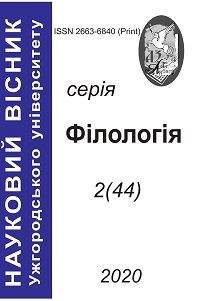COMPARATIVE ANALYSIS OF BIBLICAL PHRASEOLOGICAL UNITS WITH BLUE AND GREEN COLOUR COMPONENTS (on the example of English, Russian and Georgian)
DOI:
https://doi.org/10.24144/2663-6840.2020.2.(44).17-27Ключові слова:
phraseological unit, linguistic phenomenon, biblical expressions, colours, comparative approach, history culture and traditions.Анотація
Language as an important part of culture reflects our reality and interprets it, creating the reality in which we live. It expresses mentality of the nation, views of peoples in the world and is closely related to the history, culture and traditions of different countries.
The study of language is provided within many different disciplinary areas and from different theoretical angles, all of which inform modern approaches to linguistics.
Echoes of previous years remain today in proverbs, sayings, phraseological units, metaphors, culture symbols, etc. Lan- guage learning is a natural creative process.
A study and analysis of words cannot be done without the consideration of various features and linguistic theories. Language attracts people’s attention because of the wealth literature and knowledge enshrined in it. As is known English
Russian and Georgian are considered as one of the most vital universal languages in the world. Nothing defines a culture as distinctly as its language, and the element of language that best encapsulates a society’s values and beliefs is its proverbs. Proverbial expressions are still very much alive in everyday languages, and the daily conversation would seem rather dull without them. Biblical proverbs and sayings are the wisdom of thought.
Although English, Russian and Georgian belong to a family of different languages and systematically differs from each other, it is interesting to make comparative analysis of different lexical and phraseological units.
There are countless colours in nature. Colour is a physical, psychological, and linguistic phenomenon and a subject of analysis in many sciences, a component of many arts playing a great role in the life of society. The lexical group of colour designation is significant in creation and expression of a language picture.
The notion of colour is multifaceted, complex in its structure. It expresses not only visual perception but also connotative meanings. The diversity of the meanings of colors is due to the history of the development of states, religions and traditions. A colour palette has been reflected in mythology, legends, fairy tales, customs and various religious or mystical teachings.
In this paper, we aimed at discussing the phenomenon of blue and green colours, which has a wide range of nominal po- tential and semantic ambiguity. They are the most conservative colours in the spectrum, perceived in both human consciousness and languages with a wide range of symbolic meanings.
In linguistics, the study of colour concepts in different languages has a long tradition, presented by lots of publications. People can look at the same subject but perceive its colour differently. Colour terms differ across languages and the differences have been viewed through the prism of culture.
A phraseological unit is more complex and multi-dimensional space, as far as the language reveals its possibilities most in phraseological units. As language is a meaning of expressing thoughts, any linguistic unit (a word, phrase, saying ...) should be considered in context.
In our paper we have attempted to present phraseological units in three languages adapting bible words and expressions that made them own language property. Thus, it should be noted that phraseological units make the concentrated wisdom of all nations. They have certain pure linguistic features showing powerful universal and actually national culturological and lan- guage capacity. As far as we understand, phraseological units have their own connotative fields, analysing expressions with the above mentioned colours in the given languages, we can see that the connotative fields of the colours are not always integral. Life of biblical expressions in the modern European languages convincingly testifies to imperishability of spirit and a letter of the Book of books.
Comparative approach allows receiving information on similarity or distinction of colour concepts in different languages, national and specific, lingvocultural peculiarities, conceptual models of vision of the world and interpretations in separate languages.

